HP Omen 35L hands-on: Testing a quiet mid-tower
But there's a questionable pairing of an AMD APU and Nvidia RTX 4080 Super.
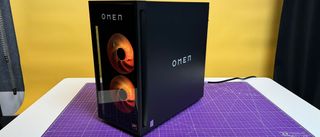
For its last several generations of desktop PCs, HP has been moving more and more toward enthusiast-style builds, with fewer proprietary parts, replaceable parts, and a focus on performance. With the HP Omen 35L, the company is moving moe toward a standard mid-tower, like many of the best gaming PCs.
It's attractive enough (perhaps with the word "Omen" on it one too many times), but in our hands-on testing, this gaming PC had what counts: gaming performance and quiet operation.
We're still waiting on final pricing for our review configuration, so we're not calling this a full review yet (that would need to consider how much you have to pay for it), but considering it has an Nvidia GeForce RTX 4080 Super, 6TB of storage, and 64GB of RAM, assume it will be expensive. Otherwise, we have our full testing below, and we hope to make this a full review once we know what this unit costs and when this configuration will be available. (Other configurations, listed below, do have pricing and availability, but don't hit this level of performance.)
Design of the HP Omen 35L
The HP Omen 35L is exactly what it says on the tin: a 35-liter mid-tower chassis packed to the brim with powerful components, including some with HP's own Omen branding. It's a boxy design that, if it wasn't for several placements of the word "Omen" in a large font, would be rather unassuming. We looked at the system in an all-black chassis, though there's also an option that's white with black accents.
The front of the system features two 140mm RGB fans behind a screen with the Omen wordmark on it. But you see the real fun on the left side. That's where there's a glass window (though some options will have a metal side panel) looking into the system. By default, that means a sea of rainbow lighting on the ARGB AIO CPU cooler, the case fans, the Kingston Fury RAM, and the GeForce RTX 4080 Super GPU. The cables you would be able to see through the window are largely hidden by shrouds.




The right side-panel is more simple: black metal with the Omen logo again. The top of the system features some ports and some square-holed grilles where the radiator from the AIO exhausts.
HP says that it plans to sell some of the Omen branded parts on its website. The 850W and 1000W power supplies, Omen fans, and the Omen AIO liquid cooler are set to go on sale individually in January 2025. In theory, you could use them in your own custom PC builds, too.
At 16.14 x 16.06 x 8.26 inches, the Omen is compact. It's smaller than the Alienware Aurora R16 (18.05 x 16.5 x 7.76 inches) and Acer Predator Orion 5000 (19.09 x 18.98 x 8.62 inches), but the Corsair One i500 is smaller at 15.3 x 11.8 x 7.6 inches. The 35L is replacing the HP Omen 40L and 25L, making it a new standard size for the company (though it sounds like the 45L may be sticking around).
HP Omen 35L Specifications
| Processor | AMD Ryzen 7 8700G |
| Motherboard | HP "Wolant" 8CF4 micro ATX motherboard (AMD B650) |
| Memory | Kingston Fury 64GB DDR5-5200 (4x 16GB, set at 3600 MT/s out of the box) |
| Graphics | OEM RTX 4080 Super (16GB GDDR6X, 2,550 MHz boost clock) |
| Storage | 6TB (2x WD Black Gen4 SDCPNRZ-2T00-1106 SSDs, 2TB Toshiba DT02ACA200 7,200-rpm HDD) |
| Networking | MediaTek Wi-Fi 7 MT7925, Bluetooth 5.4 |
| Front Ports | USB 3.2 Gen 2 Type-C, 2x USB 3.2 Gen 1 Type-A, 3.5 mm headphone jack |
| Rear Ports (Motherboard) | 4x USB 2.0 Type-A, 2x USB 3.2 Gen1 Type-A, USB 3.2 Gen 2 Type-C, 3x audio ports, Ethernet |
| Video Output (GPU) | 3x DisplayPort, 1x HDMI |
| Power Supply | 1,000W modular 80 Plus Gold Omen PSU |
| Cooling | 240mm ARGB liquid cooler, 2x 140mm case fans, 120mm exhaust fan |
| Operating System | Windows 11 Pro |
| Dimensions | 16.14 x 16.06 x 8.26 inches / 410 x 408 x 210 mm |
Ports and Upgradeability on the HP Omen 35L
On the top of the Omen, there are four ports: a headset jack, a 10Gbps USB 3.2 Type-C port, and a pair of USB 3.2 Gen 1 Type-A ports. These are easier to reach if you keep the PC on the floor than your desk, but in general I prefer the placement on top.
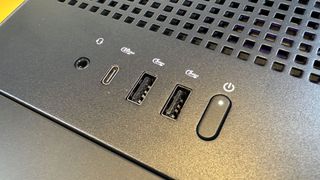
The ports on the rear of the system are attached to HP's "Wolant" micro ATX motherboard. They include four USB 2.0 Type-A ports, two USB 3.2 Type-A, a single USB 3.2 Gen 2 Type-C, an RJ-45 Ethernet jack, and three audio ports. That USB Type-C port is just 10 Gbps, while newer boards are more likely to offer something much faster. This is enough for most people, but it's not an enthusiast feature, for sure.
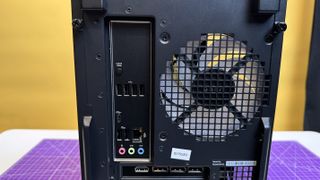
One very odd absence is the lack of HDMI on the motherboard. Lots of prebuilt companies leave this off (or cover the ports) to ensure that people plug their monitors into the GPU to get the best performance. But here, HP is using the AMD Ryzen 7 8700G with some pretty powerful integrated graphics on board. Without HDMI on the motherboard, you can never use the integrated graphics at all, even if the GPU were to fail.
Stay On the Cutting Edge: Get the Tom's Hardware Newsletter
Get Tom's Hardware's best news and in-depth reviews, straight to your inbox.
You don't need any tools to open the 35L. Each side panel is secured with two thumb screws; Loosen them and you can pull the panels off. The left side is fairly clean. You can easily reach one of the two SSD slots, while the other one (as well as the wireless card) requires removing the RTX 4080 Super.


The right side panel hides the mess of cables you can't see in the front. I'm not going to lie and say I could do a better job here — especially with the RGB hub attached to the back of the case. But I do wish it were a bit neater to compete with boutique system builders and make upgrades easier in the future.
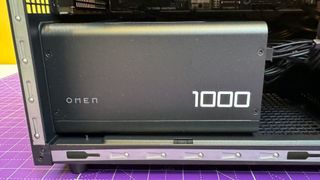
I do appreciate that HP continues to use standardized parts. The motherboard adheres to the micro ATX standard, and HP's new Omen-branded PSU is just that — a PSU. It's not using a server-grade power supply it just had lying around. (In both of those cases, I'm looking at you, Dell). If you buy this system and then get super into PC gaming, you should be able to upgrade quite a bit on your own while keeping the case. But with our stocked sample, there's not much to add at the moment.
Gaming and Graphics on the HP Omen 35L
With an Nvidia GeForce RTX 4080 Super, 64GB of RAM, and some high-end storage, I expected powerful gaming out of the Omen 35L. I wasn't disappointed.
A quick note on the RAM. HP sets the memory speeds lower than the sticks are capable for "out-of-the-box stability and quality[.]" In our case, the RAM was set at 3,600 MT/s out of the box.
"HP uses Kingston Fury 6000 MT/s memory modules, with speeds varying from 3600 MT/s to 5200 MT/s depending on whether you have 2 DIMMs or 4 DIMMs," the company told Tom's Hardware in a statement. "The highest stable overclocking frequency is limited to around 5200 MT/s for a four-DIMM setup due to CPU constraints, not the DIMMs themselves. Users can potentially push the memory speeds up to 6000 MT/s via BIOS or, in some cases, [Omen Gaming Hub], though actual performance may differ based on the specific configuration."
We tested the Omen with the out of the box RAM settings. HP's restrictions likely help limst returns and support calls from customers dealing with instability. The faster RAM would be helpful for the 8700G's integrated graphics, but since the motherboard doesn't let you use those anyway, that's a wash.
I played Alan Wake II at 2560 x 1440 on high preset with DLSS upscaling and medium ray tracing. The game ran between 30 and 45 frames per second most of the time, though there was a dip or two down to 29 fps.
The Omen 35L, with its Ryzen 7 8700G and RTX 4080 Super, plowed through many of our benchmarks. Unsurprisingly, The Corsair One and Alienware Aurora R16 with Intel Core i9-14900K and Intel Core i9-14900KF paired with RTX 4090s outperformed, while the Acer Predator Orion 5000 with an Intel Core i7-14700F and an RTX 4070 Super wasn't usually as strong.





Across our benchmarks, the Omen 35L played Shadow of the Tomb Raider, Far Cry 6, and Borderlands 3 at 4K60 or more without breaking a sweat. On Red Dead Redemption 2 at medium settings, it hit 55 fps at 4K. Only Cyberpunk 2077's ray tracing ultra preset at 4K was too much for it to handle.
The only spot in which the Omen showed any weakness was Far Cry 6 at 1080p. On the CPU bound game, the Core i7 was far faster thanks to more cores than the Ryzen 7 8700G.
To stress test the system, we ran Metro Exodus 15 times in a row on the RTX preset, which takes about half an hour. The game ran at an average frame rate of 121.82 fps, with each run falling within one frame of the others. During the test, the system was extremely quiet, which was refreshing compared to some other machines we've tested recently. The Ryzen 7 8700G ran at an average of 4.5 GHz and 55.16 degrees Celsius. The RTX 4080 Super ran at 2,084.2 MHz and measured 43.9 C.
Productivity Performance on the HP Omen 35L
With our productivity suite, the Omen 35L, the Ryzen 7 8700G, and its 64GB of RAM proved to be adequate for productivity work, though the system couldn't catch up to Intel chips with more cores.



On Geekbench 6, the Omen earned a single core score of 2,673 and a multi-core score of 12,749. The AMD APU beat the Core i7 and one Core i9 in single-core, but every Intel chip, with far more cores, won out in multi-core.
HP's WD_Black drives were the fastest on our file transfer test. The NVMe SSD copied 25GB of files at a rate of 2,417.98 MBps, the fastest of the group with the Corsair One coming in close behind. HP appears to be using OEM drives here (see model names in the table above), but it's hard to complain too much when the drive performs well.
Where the Omen faltered was on Handbrake. It took 4 minutes and 8 seconds for the rig to transcode a 4K video to 1080p, again believe it's due to the relative lack of cores on the AMD APU. The slowest Intel chip, a Core i7-14700F in the Acer, took 2:30, and the pair of Core i9 chips were even faster.
Software and Warranty on the HP Omen 35L
There's a slew of software preloaded onto the Omen 35L, but the truth is there's only one really important app. That's the Omen Gaming Hub, which lets you check out system temperatures and utilization, overclock your RAM, adjust RGB lighting, launch games, and more. HP has bloated it a bit, with sales, a partnership with GeForce Now, and a camera and voice enhancer.
That last part wouldn't feel like bloat if HP didn't also include its Enhanced Lighting software, though admittedly that's a huge virtual light ring.
Google Essentials and Google Play Games Beta are installed, as are McAfee, a Dropbox Promotion, and Adobe Offers. There are other add-ons like Booking.com and Otter.ai. It's a lot of extras for a PC that’s undoubtedly very expensive. Some of them even get bookmarks in the Edge browser!
Other HP apps include HP Smart (to set up printers, of all things), myHP (With a bunch of tips), and HP Support Assistant.
HP Omen 35L Configurations
We reviewed the HP Omen 35L with an AMD Ryzen 8700G, Nvidia GeForce RTX 4080 Super, 64GB of RAM, and 6TB of storage (two 4TB SSDs and a 2TB HDD). It also included a 1,000W power supply and an ARGB AIO CPU cooler. We're still waiting on final pricing for this unit.
The base model starts at $1,199.99 with a Ryzen 5 8500G, an air cooler with two heat pipes, 16GB of RAM, a 512GB SSD, Nvidia GeForce RTX 4060, and a 500W PSU. That's at HP.com.
At Best Buy, for $1,299.99, you can get a model similar to the entry-level one, but in "panda' white and with 1TB of storage. Jumping up to 32GB of RAM, a 4080 Super, and 850W PSU will cost $2,449.99.
If you prefer an Intel machine, HP sells an option starting at $1,269.99 with an Intel Core i5,-14400F, 4-heatpipe air cooler, 16GB of RAM, and the RTX 4060.
Bottom Line
It continues to be refreshing to see HP move its Omen desktops further into enthusiast territory. I'm happy to see a box with standardized parts, though HP has been moving further and further in that direction for years. We'll have to wait until next year, though, to see HP sell some of its new components for upgrades.
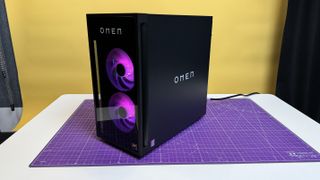
The Omen 35L, as we tested it, was powerful and quiet. The case is attractive enough, if not a bit plain, and the high-end configuration was able to power through most games with the RTX 4080 Super. The combination of that GPU with AMD's Ryzen 7 8700G is a bit questionable, though, and the company didn't answer questions about how it got to that selection.
We'll have to wait for final pricing to render a verdict here. That's likely to come on its August 21 release date. That will help us render final judgment about what kind of value you're getting here.
MORE: Best Gaming PCs
MORE: Best PC Builds
MORE: Best Gaming Laptops
Andrew E. Freedman is a senior editor at Tom's Hardware focusing on laptops, desktops and gaming. He also keeps up with the latest news. A lover of all things gaming and tech, his previous work has shown up in Tom's Guide, Laptop Mag, Kotaku, PCMag and Complex, among others. Follow him on Threads @FreedmanAE and Mastodon @FreedmanAE.mastodon.social.
-
Heat_Fan89 I purchased an Omen 30L from Amazon a few years ago and I have been quite happy with it. It has the 10th gen 10850K, with an RTX3080 and 32GB of RAM, 1TB NVME and a 2TB HDD. The only issue I have had since day one has been the subpar cooling because of the case design and the 120mm AIO. The glass side panel doesn't help things at all.Reply
Besides that they are rather attractive but if I had to buy another gaming rig, I would go with either the latest Corsair or Lenovo's version of the Corsair, the Lenovo Legion desktop. -
Avro Arrow I can't for the life of me understand why Omen would pair an APU with a high-end video card. There is literally zero reason to do so.Reply
Sure, an AMD APU will have one of the most potent IGPs in the world but it's rendered completely pointless when paired with a dedicated video card, especially one that's high-end. In fact, I would even say that it's worse than pointless because AMD G-class APUs have reduced ALU performance compared to AMD's mainstream CPUs (standard, X and X3D).
This is because AMD uses inferior ALU silicon in its APUs because they're made for people who aren't into high-end gaming or anything really demanding on their hardware. People who fit this profile would benefit far more from the power savings incurred by using an IGP instead of a dedicated card. I refer to tasks like this as "Boomer Tasks" because this is what most Boomers do on their PCs. Checking emails, using Facebook (including Facebook games like Farmville). Since the use of the AGP increases power draw and heat, there's no reason for AMD to use silicon that can clock higher than what the extra heat allows and so the performance ceiling is lower and this will hurt gaming performance.
It's not like anyone could even say that the APU's IGP is a "just in case" thing because all standard-line AM5 CPUs have IGPs already but they're tiny glorified video adapters which means that they have no negative ALU performance impact.
To most enthusiasts, this isn't exactly rocket science, it's common sense. Just the fact that Omen would offer a PC with specs like this strikes me as incompetent at worst and cynical at best. Will it work? Sure it will, but the video card will long out-live that APU.
I think that HP probably got the R7-8700G for a seriously low price. The R7-8700G seems like a product that AMD probably shouldn't have bothered making in the first place. I can't imagine that there's a huge desktop market for 8-core CPUs with reduced ALU performance caused by a world-class IGP. The price itself is actually not bad but I would personally rather have the Ryzen 7 7700 for less than $9 more. -
Notton Wow, how cheap do you have to be to omit video out on the mobo?Reply
It doesn't even have a royalty free DP, or VGA port.
I also see that the mobo has mounting holes for VRM heatsinks, and even those are missing. -
gg83 Andrew nailed it! I'm happy to see hp using standard parts and it looks much better than 3 years ago. With the deals you can get from cyber/ibuypower HP needed to step up. I wonder if Alienware will follow suit.Reply -
Giroro ReplyAvro Arrow said:I can't for the life of me understand why Omen would pair an APU with a high-end video card. There is literally zero reason to do so.
My guess is because 8700 is a more bigger-er number than last year's 7700, and the 9700 wasnt ready yet.
If there were a cheaper 8700 without an igp, I bet they would have used it. -
Avro Arrow Reply
I think you're onto something there. Generally, people who buy "brand-in-a-box" PCs like Dell/Alienware or HP/Omen are tech noobs and to them, the 8700G would sound better than anything with 7700 in it. Good call! ;)(y)Giroro said:My guess is because 8700 is a more bigger-er number than last year's 7700, and the 9700 wasnt ready yet.
If there were a cheaper 8700 without an igp, I bet they would have used it.
Most Popular

